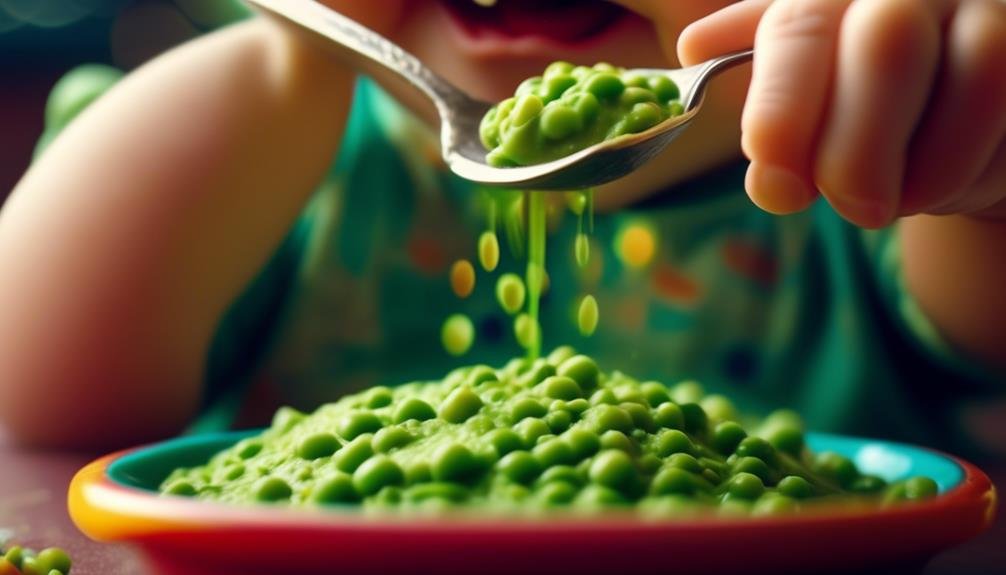"Cherishing Little Steps - A Haven for Baby and Family Journeys"
Toddler Feeding Milestones
Have you ever wondered if there are specific milestones your toddler should be reaching when it comes to feeding? Well, you're not alone. Many parents are curious about the developmental stages their little ones go through in terms of eating.
In this discussion, we will explore the truth behind toddler feeding milestones and how they can impact your child's overall growth and development.
So, let's dive into this fascinating topic and discover what you need to know to ensure your toddler's healthy eating habits!
Key Takeaways
- Toddler feeding milestones are important for healthy development and well-being.
- Nutritional needs change as toddlers grow and go through developmental stages.
- Milestones mark important transitions in eating habits and abilities.
- Common feeding challenges include picky eating and difficulty with self-feeding utensils.
Introduction: The Importance of Toddler Feeding Milestones

Understanding the importance of toddler feeding milestones is crucial for parents and caregivers to ensure the healthy development and well-being of their little ones. As toddlers grow, their nutritional needs change, and they go through various developmental stages. These milestones mark important transitions in their eating habits and abilities.
The significance of developmental stages can't be overstated. During the first year of life, infants rely solely on breast milk or formula for their nutrition. However, as they transition into toddlerhood, they begin to explore solid foods and develop the skills necessary for self-feeding. This transition is vital for the proper growth and development of their bodies and brains.
Alongside these developmental stages, parents and caregivers may encounter common feeding challenges. Toddlers are known for being picky eaters, and it can be frustrating for adults when they refuse certain foods or only want to eat a limited range of items. Additionally, toddlers may go through phases of food refusal or have difficulty with self-feeding utensils.
Understanding these common challenges and learning how to address them is essential for maintaining a healthy and positive feeding relationship with your toddler. By providing a variety of nutritious foods, creating a positive eating environment, and offering age-appropriate utensils, you can help your little one navigate these developmental stages and establish healthy eating habits that will last a lifetime.
When to Introduce Solid Foods
To ensure the healthy development and nutrition of your toddler, it's important to know when to introduce solid foods into their diet. Introducing pureed foods and transitioning from a solely milk-based diet is an important milestone in your child's journey towards independent eating. Most experts recommend starting solids around six months of age, although every child is different and it's best to consult with your pediatrician.
Introducing pureed foods is a traditional approach to transitioning your baby to solid foods. Purees can be made from a variety of fruits, vegetables, and grains, providing essential nutrients and exposing your little one to new flavors and textures. Start with single-ingredient purees, such as mashed avocado or cooked sweet potato, and gradually introduce more complex combinations.
On the other hand, baby-led weaning is an alternative method gaining popularity. This approach involves allowing your baby to self-feed by offering them soft, age-appropriate finger foods. The idea behind baby-led weaning is to encourage independence and develop fine motor skills. Offer foods like cooked carrot sticks or banana slices that are easy for your baby to grasp.
Transitioning From Bottle to Cup

If you want to help your toddler transition from a bottle to a cup, it's important to do so gradually and patiently. This process is an important milestone in your child's development as it promotes their independence and prepares them for the weaning process.
Start by introducing a sippy cup around six to nine months of age, when your baby is able to sit up and hold objects. Choose a cup with handles and a soft spout that resembles a bottle nipple to make the transition easier. Offer it during meal times or when your toddler is thirsty. At first, your child may only play with the cup or take a few sips, but that's okay. Remember to stay patient and supportive.
As your toddler becomes more comfortable with the sippy cup, gradually reduce their bottle feedings. Start by replacing one bottle feeding with a cup feeding, and slowly increase the number of cup feedings over time. It's important to follow your child's cues and let them take the lead in this process.
Encourage your toddler to practice holding and drinking from the cup independently. This will help develop their fine motor skills and promote self-feeding. Be prepared for spills and messes along the way, as your child learns how to drink from an open cup without a lid.
Transitioning from a bottle to a cup is a gradual process that requires patience and support. Remember to be consistent and offer praise and encouragement to your toddler as they make progress.
Developing Self-Feeding Skills
When introducing your toddler to self-feeding skills, it's important to encourage their independence and fine motor development. Developing independence in feeding not only boosts your child's confidence, but it also helps them learn new skills and become more self-sufficient. Sensory exploration is another crucial aspect of self-feeding. Allowing your toddler to touch, feel, and explore different textures and tastes of food helps them develop their sensory processing skills.
To promote independence, start by offering your child finger foods that are easy to pick up, such as small pieces of fruit or soft cooked vegetables. Encourage them to use their hands to feed themselves, even if it gets messy at first. Gradually introduce utensils like spoons and forks, and give them plenty of opportunities to practice using them. You can also involve your child in meal preparation by allowing them to help with simple tasks like stirring or pouring.
Sensory exploration can be fostered through a variety of food textures and flavors. Offer your child a range of foods with different tastes and consistencies, such as crunchy vegetables, smooth yogurt, or chewy bread. Allow them to touch and explore their food, as this helps develop their sensory awareness and can make mealtimes more enjoyable.
Using Utensils: Spoon, Fork, and Beyond

Encourage your toddler's independence and fine motor skills by introducing them to using utensils such as spoons, forks, and beyond. Spoon training is an important milestone in a child's development, as it helps them learn how to scoop and feed themselves. It can be messy at first, but with practice, your little one will become more skilled at using a spoon. You can start by offering finger foods that are easy to pick up and self-feed, such as small pieces of soft fruit, cooked vegetables, or pasta. As your toddler becomes more comfortable with using a spoon, you can gradually introduce other utensils like forks. Teaching them how to hold a fork and stab food can be challenging, but it is a valuable skill that will help them become more independent eaters.
To help you navigate through this stage, here is a table summarizing some tips for introducing utensils to your toddler:
| Utensil Training Tips |
|---|
| Start with finger foods |
| Offer a variety of textures |
| Encourage self-feeding |
Encouraging Healthy Eating Habits
To cultivate healthy eating habits in your toddler, it's important to provide a variety of nutritious foods and create a positive mealtime environment. By encouraging independence and creating a positive mealtime environment, you can help your child develop healthy eating habits that will benefit them throughout their lives.
Here are five strategies to consider:
- Offer a variety of foods: Introduce different fruits, vegetables, whole grains, and proteins to your child's diet. This will expose them to different flavors and textures, helping them develop a taste for healthy foods.
- Be a role model: Children often imitate their parents' eating habits. Show your child that you enjoy eating a variety of nutritious foods by including them in your own meals.
- Make mealtime enjoyable: Create a pleasant atmosphere during meals by sitting together as a family, engaging in conversation, and avoiding distractions like screens. This will make mealtime a positive experience for your child.
- Encourage self-feeding: As your child grows, encourage them to feed themselves using utensils. This will help develop their motor skills and foster independence.
- Celebrate small victories: Praise your child when they try new foods or eat a balanced meal. This positive reinforcement will encourage them to continue making healthy choices.
Overcoming Picky Eating Behaviors

Overcoming picky eating behaviors can be a challenge, but with patience and persistence, you can help expand your child's food preferences and ensure they receive a balanced diet. It's important to remember that picky eating is a normal part of a child's development and it often stems from a fear of new foods or a desire for control. By using effective picky eating strategies, you can help your child overcome their aversions and develop a wider range of food preferences.
One strategy you can try is introducing new foods gradually. Start by offering small portions of unfamiliar foods alongside their favorite dishes. Encourage your child to explore the new food, but don't force them to eat it. Another strategy is to make mealtime fun and interactive. Get your child involved in meal preparation or allow them to choose between two healthy options. This gives them a sense of control and may increase their willingness to try new foods.
To track your progress and keep a record of your child's expanding food preferences, you can use the following table:
| Food Category | Preferred Foods | New Foods to Try |
|---|---|---|
| Fruits | Apples, Bananas | Kiwi, Mango |
| Vegetables | Carrots, Broccoli | Peas, Brussels Sprouts |
| Proteins | Chicken, Fish | Tofu, Lentils |
Tips for Mealtime Success
Looking for ways to make mealtime more successful for your toddler? Mealtime can often be a challenging and stressful experience, but implementing some simple mealtime strategies can help create a positive and enjoyable environment for your little one. Here are five tips to help you navigate mealtime with success:
- Create a routine: Establish a consistent mealtime routine that includes regular mealtimes and snacks. Toddlers thrive on routine and knowing what to expect can help them feel more secure and relaxed during meals.
- Offer a variety of foods: Introducing new foods can be a daunting task, but it's important to expose your toddler to a wide range of flavors and textures. Offer a variety of fruits, vegetables, grains, and proteins to encourage a well-rounded diet.
- Be a role model: Children often imitate the behaviors of those around them, so make sure to be a positive role model during mealtimes. Show enthusiasm for healthy foods and eat together as a family whenever possible.
- Make it fun: Get creative with presentation and make mealtime a fun and engaging experience. Use cookie cutters to create fun shapes, arrange food in colorful patterns, or involve your toddler in meal preparation.
- Be patient: Remember that introducing new foods takes time and patience. It's normal for toddlers to be hesitant or even resistant to trying new foods. Keep offering a variety of options and be patient as your little one learns to explore new flavors.
Frequently Asked Questions
How Can I Tell if My Toddler Is Ready to Start Self-Feeding?
You can tell if your toddler is ready to start self-feeding by observing if they can sit up independently, use their hands to grab food, and show an interest in feeding themselves.
What Are Some Common Signs That My Toddler Is Ready to Transition From a Bottle to a Cup?
When it's time for your little one to say goodbye to the bottle and hello to the cup, keep an eye out for signs like showing interest in your cup, holding their own bottle, and being able to drink from a straw. It's all about timing and finding the right techniques to introduce the cup.
Should I Be Concerned if My Toddler Is Not Interested in Using Utensils Yet?
Don't worry if your toddler isn't interested in using utensils yet. It's a common milestone that varies for each child. Keep offering utensils and let them explore self-feeding at their own pace.
How Can I Encourage My Toddler to Try New Foods and Expand Their Palate?
You can encourage your toddler to try new foods and expand their palate by offering a variety of options, modeling adventurous eating, involving them in meal preparation, and making mealtime a positive and enjoyable experience.
Are There Any Strategies for Dealing With Mealtime Tantrums or Resistance From My Toddler?
When dealing with mealtime tantrums or resistance from your toddler, try to stay calm and patient. Offer a variety of foods and involve them in meal preparation. Remember, picky eaters are common at this age, and it takes time for their palates to develop.
Conclusion
In conclusion, understanding and supporting your toddler's feeding milestones is crucial for their growth and development.
By introducing solid foods at the appropriate time and encouraging self-feeding skills, you're setting them up for a lifetime of healthy eating habits.
Remember, every child is unique, and picky eating behaviors can be overcome with patience and persistence.
With these practical tips, mealtime can be a success for both you and your little one.



Undoubtedly, there is a great deal to learn on this topic. I agree with everything you said. It was all very nicely said. I loved every quote, and I appreciate you sharing the information. Continue inspiring and sharing with others.
I loved you even more than you’ll say here. The picture is nice and your writing is stylish, but you read it quickly. I think you should give it another chance soon. I’ll likely do that again and again if you keep this walk safe.
Thanks for sharing. I read many of your blog posts, cool, your blog is very good.